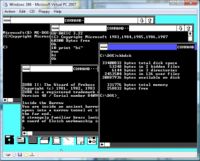Difference between revisions of "Windows 2.0"
| Line 1: | Line 1: | ||
| + | [[Image:Windows 386 running.jpg|200px|thumb|right|Windows/386 running multiple VDM's]] | ||
Windows 2.0 was the second release of the Microsoft Windows enviroment for [[MS-DOS]]. It was not a commercial sucess, however it furthered the development of the kernel so that it could use XMS memory, and it later introduced a 286 specific version that could do some limited multitasking with MS-DOS, and a 386 specific version that could spawn multiple [[VDM]]'s. | Windows 2.0 was the second release of the Microsoft Windows enviroment for [[MS-DOS]]. It was not a commercial sucess, however it furthered the development of the kernel so that it could use XMS memory, and it later introduced a 286 specific version that could do some limited multitasking with MS-DOS, and a 386 specific version that could spawn multiple [[VDM]]'s. | ||
| Line 4: | Line 5: | ||
== Windows/286 == | == Windows/286 == | ||
| + | This version had some specific code to the 80286 cpu allowing limited MS-DOS multitasking. However since each instance of MS-DOS consumed the same limited 640kb memory pool, it was largely ineffective. | ||
== Windows/386 == | == Windows/386 == | ||
| + | [[Image:Windows 386 2.1 front.jpg|150px]] | ||
| + | [[Image:Windows 386 2.1 back.jpg|150px]] | ||
| + | |||
Windows/386 was Microsoft's first product to allow people to directly use the V86 mode of the 80386 cpu. With enough expanded memory you could run several virtual MS-DOS machines. | Windows/386 was Microsoft's first product to allow people to directly use the V86 mode of the 80386 cpu. With enough expanded memory you could run several virtual MS-DOS machines. | ||
{{stub}} {{nav Microsoft Windows}} | {{stub}} {{nav Microsoft Windows}} | ||
[[Category:Operating Enviroments]] | [[Category:Operating Enviroments]] | ||
Revision as of 03:05, 12 September 2009
Windows 2.0 was the second release of the Microsoft Windows enviroment for MS-DOS. It was not a commercial sucess, however it furthered the development of the kernel so that it could use XMS memory, and it later introduced a 286 specific version that could do some limited multitasking with MS-DOS, and a 386 specific version that could spawn multiple VDM's.
It was superceded by Windows 3.0.
Windows/286
This version had some specific code to the 80286 cpu allowing limited MS-DOS multitasking. However since each instance of MS-DOS consumed the same limited 640kb memory pool, it was largely ineffective.
Windows/386
Windows/386 was Microsoft's first product to allow people to directly use the V86 mode of the 80386 cpu. With enough expanded memory you could run several virtual MS-DOS machines.
| v • d • e Microsoft Windows Versions, Vendors and Related |
|---|
| 16 bit - Windows 1.0 • Windows 2.0 • Windows 3.0 • Windows 3.1 • Windows 3.2
Hybrid 32/16 bit - win32s • Windows 95 • Windows 98 • Windows ME 32 bit - Windows NT 3.1 • Windows NT 3.5 • Windows NT 3.51• Windows NT 4.0 |


